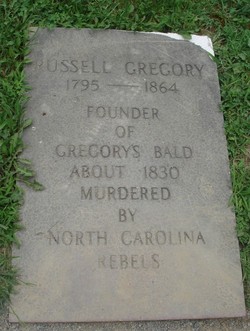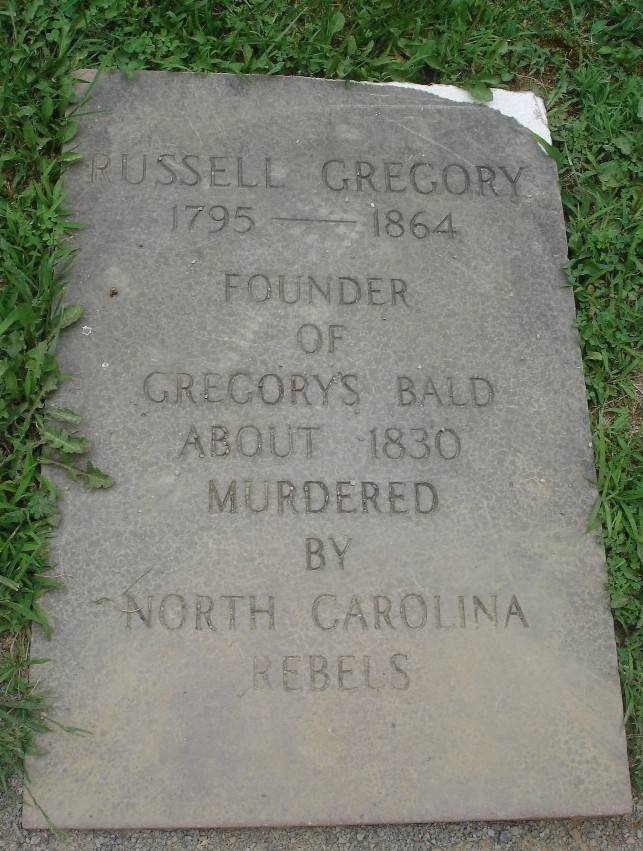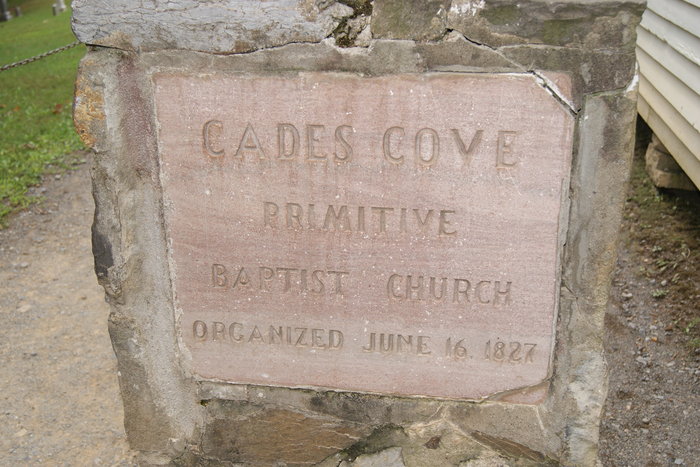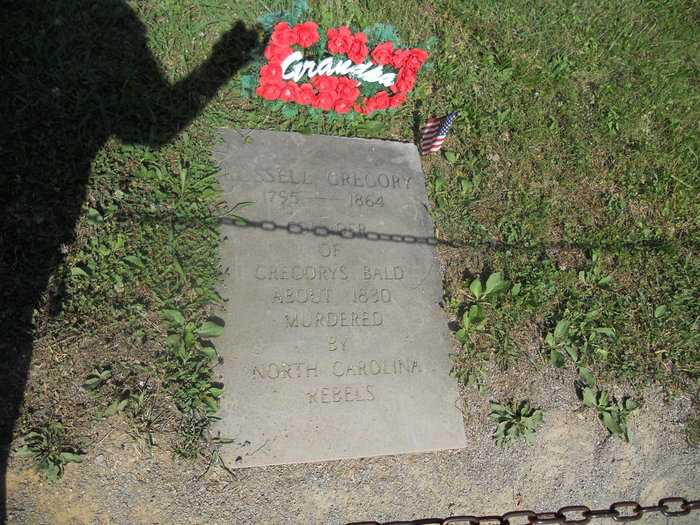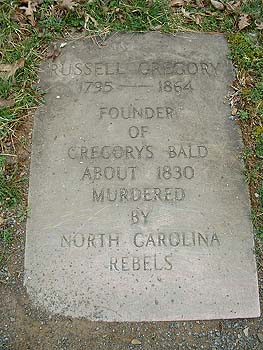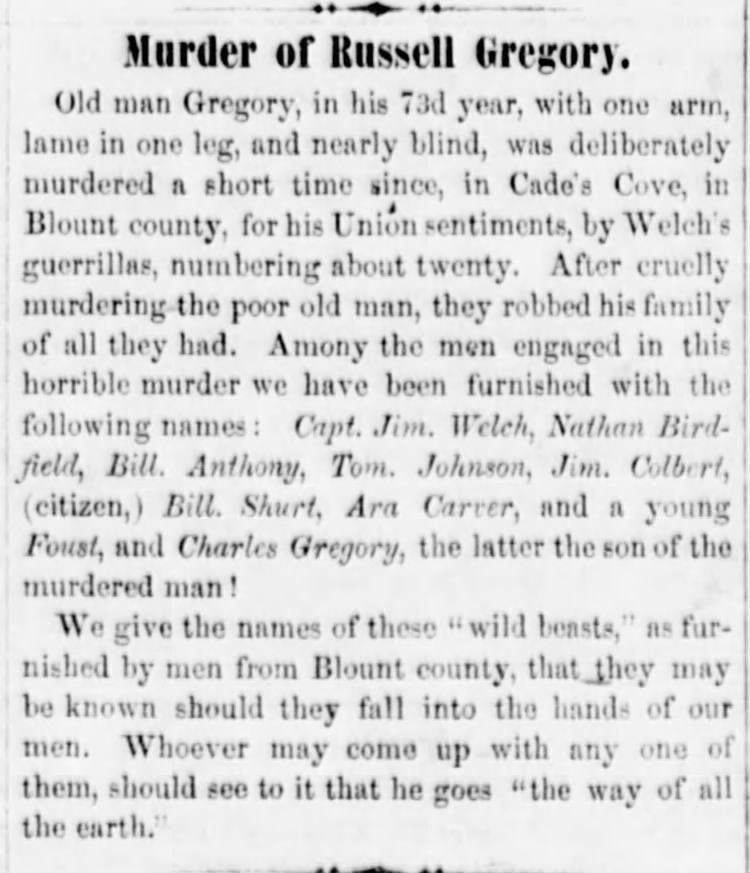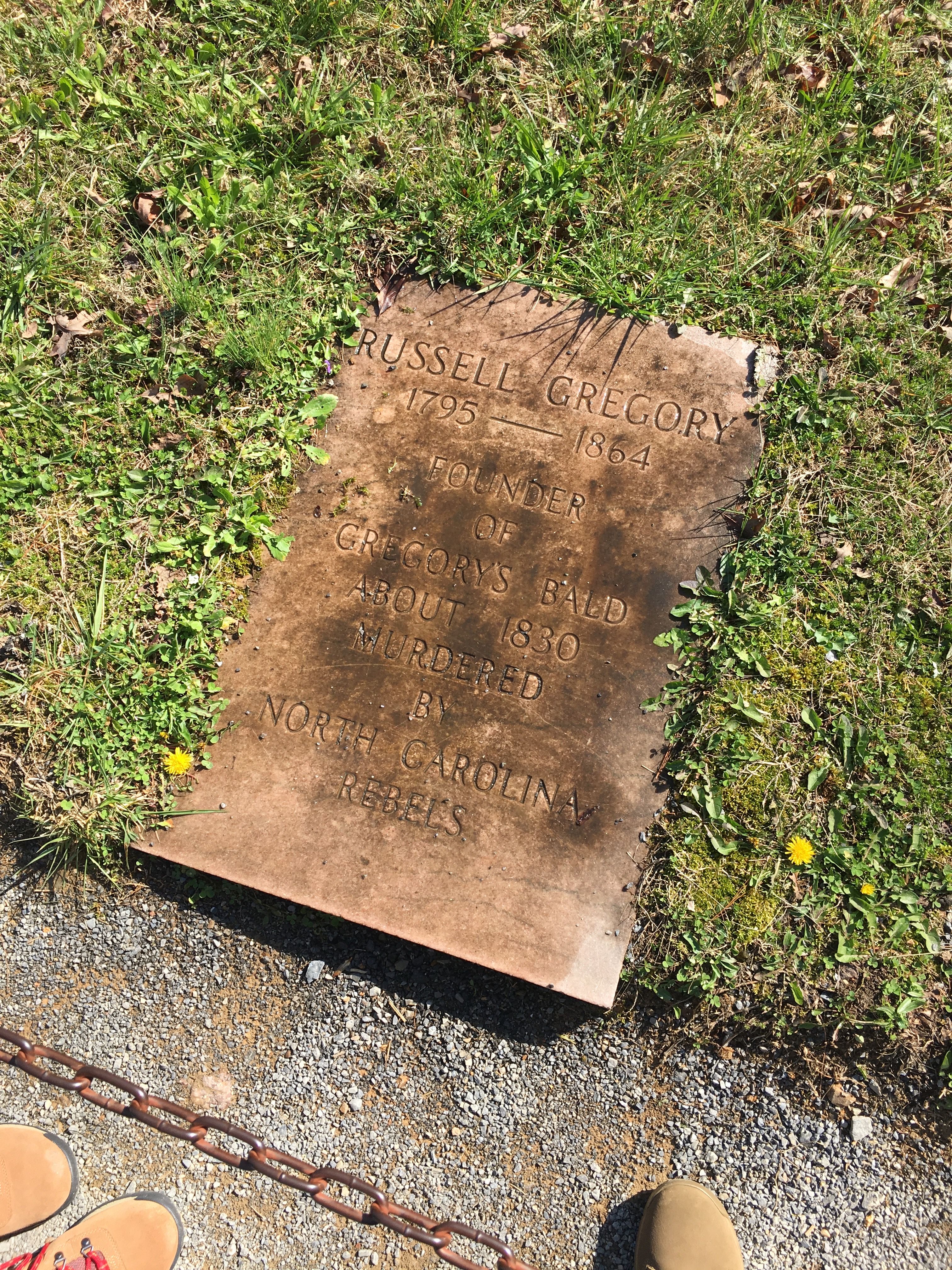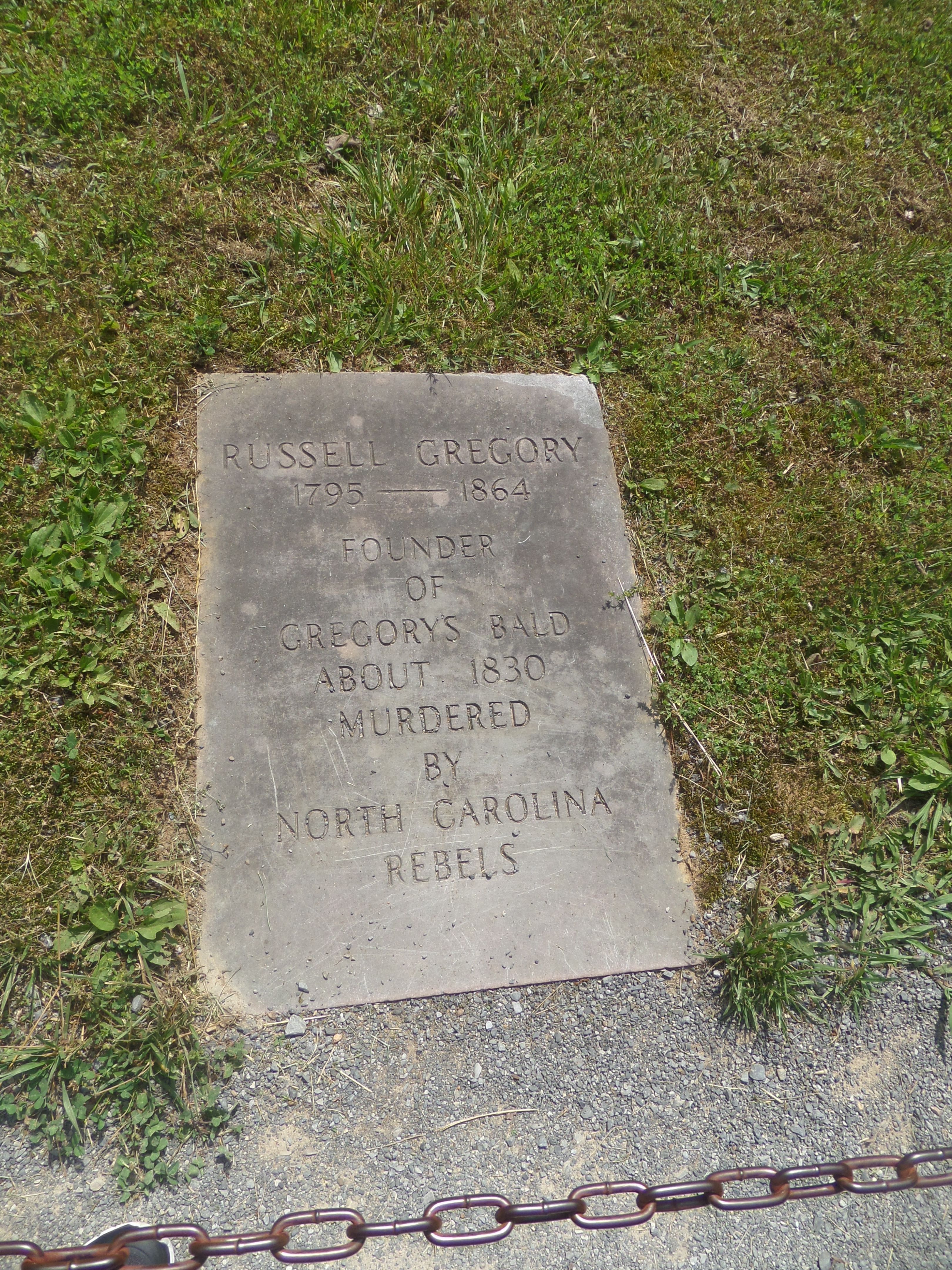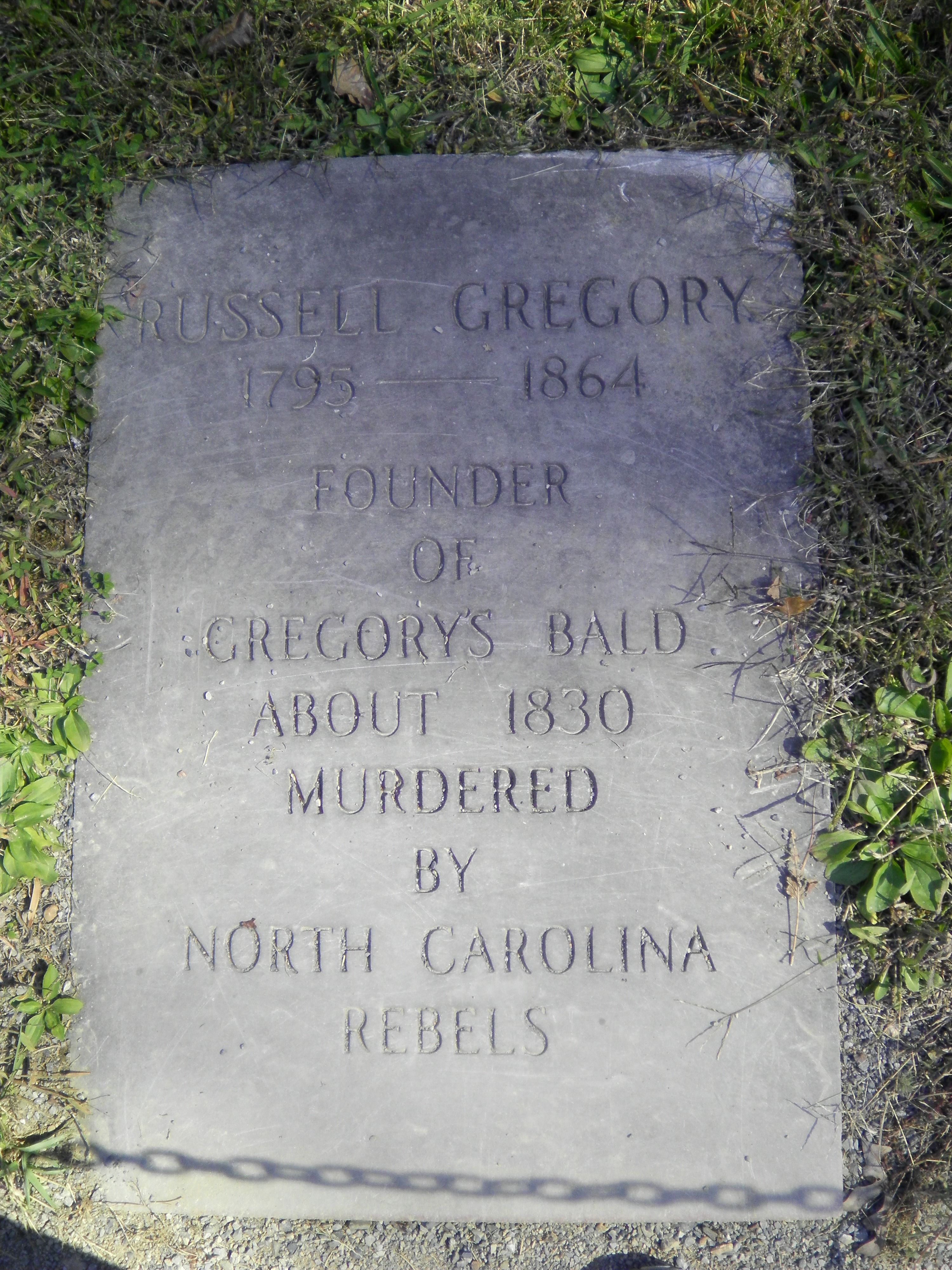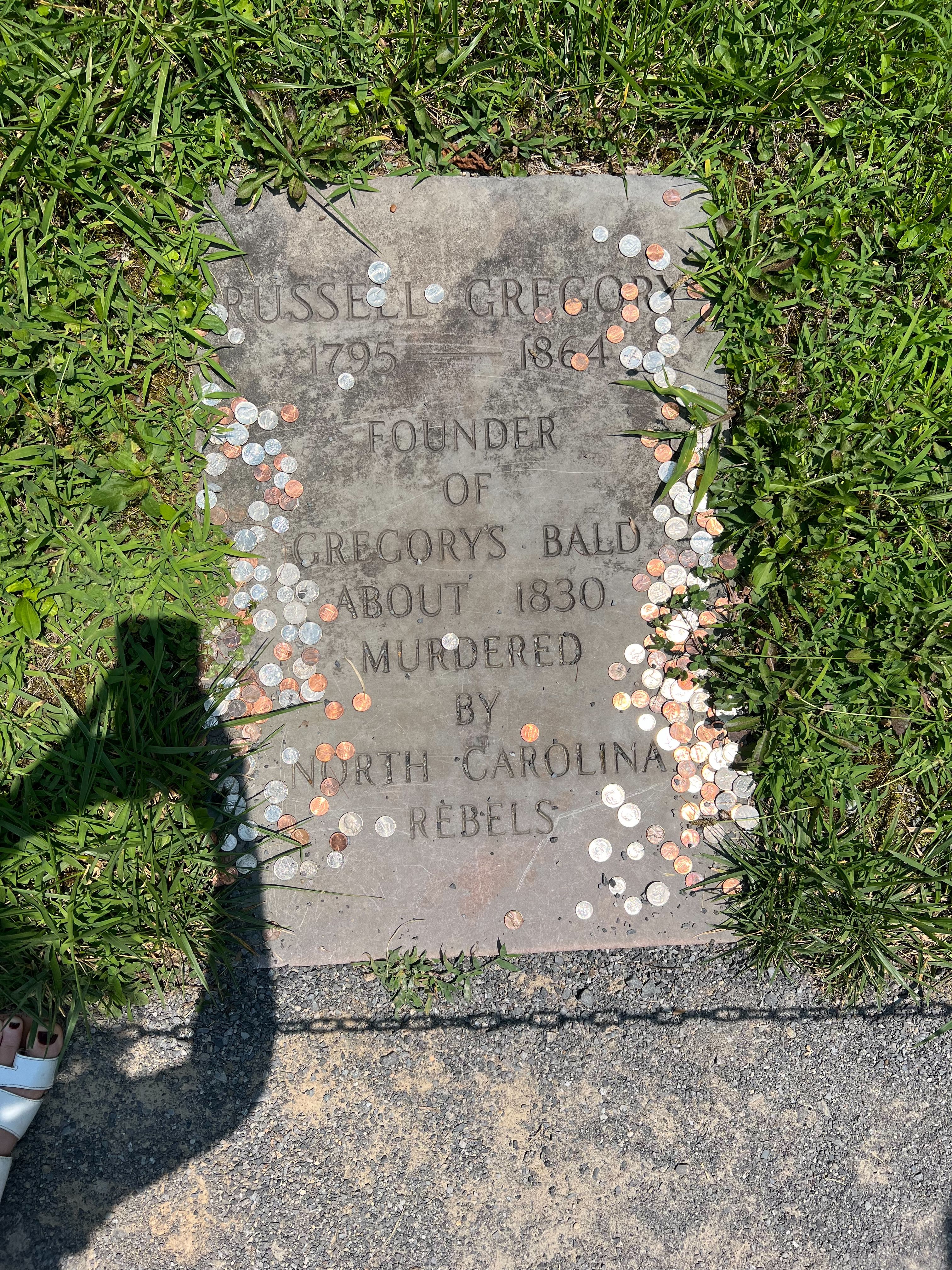Thus far, no records have been found of land titles for Russell Gregory in Cades Cove. Nevertheless, there are references to boundaries joining "Russell Gregory" in recorded transactions in the 1860s and 1870s. A land transaction of record that does involve Russell Gregory is that of a partnership purchase in 1853 with Daniel Foute, John Coffin, and Richard Wilson of a large tract of land in North Carolina. This 1,550 acres of land ran along the state line and included a portion of what is now Gregory's Bald. Some of the land was eventually purchased by the Kitchens Lumber Company for logging purposes. Later, when the land was transferred to the State of North Carolina for the park, it was discovered that Russell Gregory's title had never been vacated. The Gregory family decided the cost of pursuing the claim was too extensive, so the courts declared the title clear.
Records indicate that Russell was a member of a "Jury of View" to establish a road from Cades Cove to the Parson's Turnpike. He was appointed supervisor for the construction of this road in 1838.
The Cherokee name for Gregory Bald was "Tsistu'yi," or "Rabbit Place." According to tribal lore, the chief of all rabbits— known simply as the Great Rabbit— lived at the summit. The rabbit, considered by the Cherokee to be sly and mischievous, was a key figure in tribal legends, showing the importance the tribe placed upon the mountain.
The mountain was listed by Arnold Guyot in his 1856 survey of the Smokies. Although Guyot gave it the name "Great Bald's Central Peak" and measured its elevation at 4,922 feet, the name "Gregory Bald" was given to the mountain by Cades Cove residents in honor of Russell Gregory (1795-1864), a prominent Cades Cove settler. Gregory used the mountain to graze cattle during the spring and summer, when the fields in the cove were needed for growing crops. He lived atop the mountain during this part of the year in a circular stone house near the mountain's summit. Unfortunately, the house is no longer standing. Gregory - like most Cades Cove residents supported the Union during the American Civil War - was murdered by Confederate rebels in December of 1864.
There are at least three prominent accounts of the murder of Russell Gregory. The first account states that after successfully repelling a confederate incursion into the Cove, Russell was later drug from his home during the night and slain in retaliation. Russell, with the help of "Old Long Tom", was responsible for leading that initial resistance. The second account maintains that Russell was shot early in the morning while fleeing the home of his son, Druary Gregory, into the nearby woods. The final account is the one I grew up hearing. During the Civil War, it was not uncommon for small rouge groups of confederate rebels to raid areas for food and shelter. One such group entered the cove in December of 1864 and set up camp in the hollow a short distance from Russell's home. Russell discovered that the group had slaughtered a calf for dinner, so he approached the group to demand payment for the calf. After a brief argument, one of the soldiers shot Russell. He apparently died later that evening. There is a fourth account - which is a variation of this one - mentioned in A. Randolph Shield's book "The Cades Cove Story." Oral tradition has much to offer, but with any account, it can become distorted over the years.
Russell Gregory owned a muzzle-loading rifle named "Old Long Tom", which continues to be passed down through the Gregory line to this day. The rifle was passed down to the following descendants:
Russell Gregory
Walter Gregory
James Elias "Bud" Gregory
Andrew "Andy" K. Gregory
Frantz Guinn Gregory
Ralph Clinton Gregory
(Private)
Children of Russell and Susan Hill Gregory not listed below:
1. Elizabeth Jane Gregory
Thus far, no records have been found of land titles for Russell Gregory in Cades Cove. Nevertheless, there are references to boundaries joining "Russell Gregory" in recorded transactions in the 1860s and 1870s. A land transaction of record that does involve Russell Gregory is that of a partnership purchase in 1853 with Daniel Foute, John Coffin, and Richard Wilson of a large tract of land in North Carolina. This 1,550 acres of land ran along the state line and included a portion of what is now Gregory's Bald. Some of the land was eventually purchased by the Kitchens Lumber Company for logging purposes. Later, when the land was transferred to the State of North Carolina for the park, it was discovered that Russell Gregory's title had never been vacated. The Gregory family decided the cost of pursuing the claim was too extensive, so the courts declared the title clear.
Records indicate that Russell was a member of a "Jury of View" to establish a road from Cades Cove to the Parson's Turnpike. He was appointed supervisor for the construction of this road in 1838.
The Cherokee name for Gregory Bald was "Tsistu'yi," or "Rabbit Place." According to tribal lore, the chief of all rabbits— known simply as the Great Rabbit— lived at the summit. The rabbit, considered by the Cherokee to be sly and mischievous, was a key figure in tribal legends, showing the importance the tribe placed upon the mountain.
The mountain was listed by Arnold Guyot in his 1856 survey of the Smokies. Although Guyot gave it the name "Great Bald's Central Peak" and measured its elevation at 4,922 feet, the name "Gregory Bald" was given to the mountain by Cades Cove residents in honor of Russell Gregory (1795-1864), a prominent Cades Cove settler. Gregory used the mountain to graze cattle during the spring and summer, when the fields in the cove were needed for growing crops. He lived atop the mountain during this part of the year in a circular stone house near the mountain's summit. Unfortunately, the house is no longer standing. Gregory - like most Cades Cove residents supported the Union during the American Civil War - was murdered by Confederate rebels in December of 1864.
There are at least three prominent accounts of the murder of Russell Gregory. The first account states that after successfully repelling a confederate incursion into the Cove, Russell was later drug from his home during the night and slain in retaliation. Russell, with the help of "Old Long Tom", was responsible for leading that initial resistance. The second account maintains that Russell was shot early in the morning while fleeing the home of his son, Druary Gregory, into the nearby woods. The final account is the one I grew up hearing. During the Civil War, it was not uncommon for small rouge groups of confederate rebels to raid areas for food and shelter. One such group entered the cove in December of 1864 and set up camp in the hollow a short distance from Russell's home. Russell discovered that the group had slaughtered a calf for dinner, so he approached the group to demand payment for the calf. After a brief argument, one of the soldiers shot Russell. He apparently died later that evening. There is a fourth account - which is a variation of this one - mentioned in A. Randolph Shield's book "The Cades Cove Story." Oral tradition has much to offer, but with any account, it can become distorted over the years.
Russell Gregory owned a muzzle-loading rifle named "Old Long Tom", which continues to be passed down through the Gregory line to this day. The rifle was passed down to the following descendants:
Russell Gregory
Walter Gregory
James Elias "Bud" Gregory
Andrew "Andy" K. Gregory
Frantz Guinn Gregory
Ralph Clinton Gregory
(Private)
Children of Russell and Susan Hill Gregory not listed below:
1. Elizabeth Jane Gregory
Inscription
Founder of Gregory's Bald about 1830
Murdered by North Carolina Rebels
Gravesite Details
Killed By North Carolina Rebels. My grandmother said that she thought Russell's first name was John (John Russell Gregory), and that his father's name was John. This is passed down family oral tradition and cannot be substantiated.
